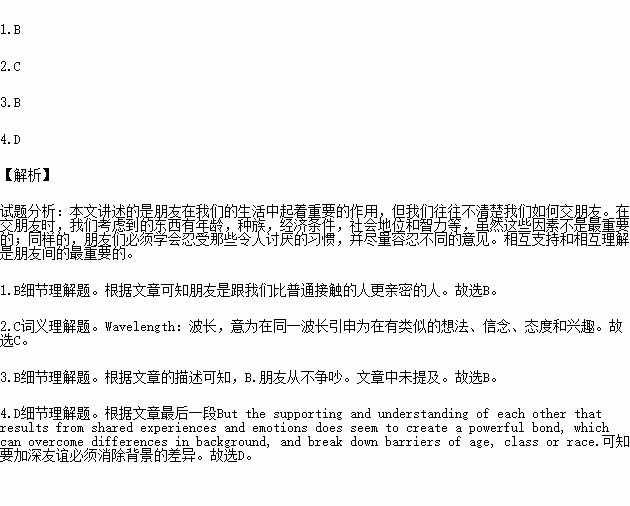题目内容
Friends play an important part in our lives, and although we may take friendship for granted, we often don't clearly understand how we make friends. While we get on well with a number of people, we are usually friends with only a very few---for example, the average among students is about 6 per person. In all the cases of friendly relationships, two people like one another and enjoy being together, but beyond that, the degree of intimacy(亲密) between them and the reasons for the shared interests vary enormously. As we get to know people, we take into account things like age, race, economic conditions, social position, and intelligence. Although these factors are not of prime importance, it is more difficult to get on with people when there is a marked difference in age and background.
Some friendly relationships can be kept on argument and discussion, but it is usual for close friends to have similar ideas and beliefs, to have attitudes and interests in common ---they often talk about “being on the same wavelength.” It generally takes time to reach this point. And the more intimately involved people become, the more they rely on one another. People want to do friends favors and hate to break a promise. Equally, friends have to learn to put up with annoying habits and try to tolerate differences of opinion.
In contrast with marriage, there are no friendship ceremonies to strengthen the association between two persons. But the supporting and understanding of each other that results from shared experiences and emotions does seem to create a powerful bond, which can overcome differences in background, and break down barriers of age, class or race.
1.According to the author, ____.
A. all those who get on well with each other are friends
B. friends are closer than people who just get on with each other
C. everyone understands clearly how to make friends
D. every student has 6 friends
2.In paragraph 2, “being on the same wavelength” means ____.
A. using the same frequency while taking
B. keeping the same friendly relationship as other people do
C. having similar ideas, beliefs, attitudes and interests
D. having the same background
3.Which of the following is not implied in the passage?
A. Even friends may have differences of opinion.
B. Friends never argue with each other.
C. It generally takes time for people to become close friends.
D. Someone’s habits may annoy his friends.
4.To strengthen friendly relationship, people ____.
A. must hold friendship ceremonies
B. have to eliminate(消除) differences in background
C. should make friends with those who are of the same age and of the same race
D. should support and understand each other through shared experiences and emotions


 ) 并在其下面写出该加的词。
) 并在其下面写出该加的词。